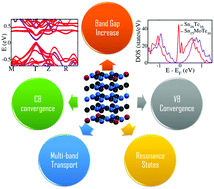Molybdenum as a versatile dopant in SnTe: a promising material for thermoelectric application
Abstract
The key to enhancing the thermoelectric performance of SnTe is to engineer its electronic structure by doping. It is essential that the beneficial features are exhibited at the Fermi level so as to exploit the benefits without the use of a co-dopant. We report molybdenum as such a versatile dopant in SnTe. The first-principles calculations reveal that Mo is able to introduce resonance levels as well as increase the band gap in SnTe. It not only causes the convergence of light and heavy hole valence sub-bands but also does so in the conduction band. The unique feature is the Rashba splitting of the conduction bands, leading to multiband transport. The transport properties calculated using Boltzmann transport equations predict the dual nature of the resonant dopant with a promising ZT of ∼1.84 and ∼1.1 as a p- and an n-type dopant, respectively, in SnTe at 800 K.

- This article is part of the themed collection: Energy Advances 2022 Hot Papers


 Please wait while we load your content...
Please wait while we load your content...